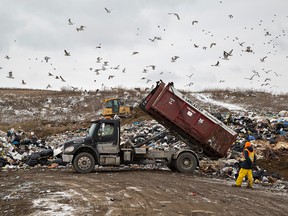Zero Waste Oxford responds to Waste-Free strategy

Article content
Zero Waste Oxford is pleased the province is moving forward with a strategy for its Waste-Free Ontario Act but hopes it might pick up the pace a little.
“The pace at which the province as a whole moves to being waste-free will speed the creation of more jobs in the circular economy,” said Zero Waste Oxford co-chair Bryan Smith. “That’s obviously a priority, and especially for Zero Waste Oxford, where we want to move ahead quickly to create good jobs in areas of innovation that will entice young people to stay in Oxford or to return. Those innovations would be environmentally sustainable as well as providing economic and social benefits for our community.”
The aim of the 2016 Waste Free Ontario Act is to reduce the 11.5 million tonnes of waste that is sent to Ontario landfills each year, create jobs and prevent climate change.
Greenhouse gas emissions from Ontario's waste have risen by 25 per cent between 1990 and 2012, as the landfill volumes have also increased.
The province recently released a proposed strategy for the act, and was seeking comments for its final strategy until the end of January.
In a letter addressed to Marc Peverini, senior policy analyst with the Ministry of the Environment and Climate Change, Zero Waste Oxford, an agent in Oxford’s Community Sustainability Plan and component of Future Oxford, provided a detailed response.
“We think the province has great goals but might move there more quickly,” Smith said. “There are places that are further along … that can show them how to do things. I would suggest Oxford County is one of those places.”
Oxford County, one of the first communities to engage in the Blue Box program back in the 1970s, has much higher recycling rates of 60 to 70 per cent, compared to an average of over 40 per cent for the rest of the province.
According to the Oxford Community Wellbeing Survey 88.9 per cent of adults feel they have a personal responsibility to help protect the natural environment.
Smith also pointed out that both Cami and TMMC are zero-waste-to-landfill plants.
The province is currently asking for a 30 per cent improvement in diversion rates by 2020, 50 per cent by 2030 and 80 per cent by 2050.
Oxford County committed to zero waste by 2025.
“We suggest they could move faster than this…” Smith said. “Oxford can assist all of Ontario by producing less garbage ourselves.”
Zero Waste Oxford also suggested a collaboration of municipalities work together to make sure new and emerging technologies are safe and adequate.
“We want to make sure we get safe technologies and one that is right for Oxford County,” Smith said.
The organization is also calling on the program to identify any products, such as polystyrene or Styrofoam, “that are expensive to recover, recycle or reuse are candidates for bans.”
“Styrofoam is extremely difficult to reprocess into anything of value,” Smith said.
Smith also points out that Californian experience with moving to a circular economy, rather than linear, has provided a boost to the economy and the creation of quality jobs.
The response letter also includes comments recommending “the closure of landfills and the ban of expanded and new ones, and the careful management of post-closure sites is in the interest of Ontarians.”
“This would mean the province could realize the goal of a Waste-Free Ontario sooner by actively discouraging landfilling as it might discourage other destructive handling of material,” the document read.